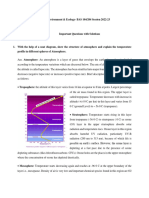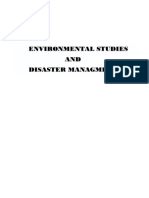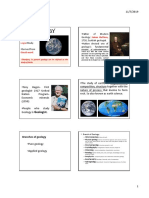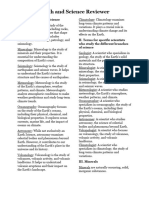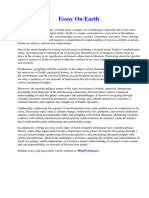Unit-1 EVS, Arvind Negi
Uploaded by
Anshika SUnit-1 EVS, Arvind Negi
Uploaded by
Anshika SSTUDY MATERIAL FOR COMPULSORY COURSE
ON
ENVIRONMENTAL STUDIES
Unit-1
Introduction to Environmental Studies
Arvind Negi
Department of Environmental Studies IPCFW,
University of Delhi, New Delhi 110007
LESSON-1
INTRODUCTION TO ENVIRONMENTAL STUDIES
The term "environment" refers to the natural surroundings and conditions in which living
organisms exist. It encompasses all the physical, chemical, and biological factors that influence
the growth, development, and survival of organisms.
the term Environment is derived from French word ‘Environ’ which literally means
‘surrounding’. Anything and everything which surrounds us i.e., all living beings or biotic
components (microbes, plants and animals) and non-living or abiotic components (air, water,
sunlight etc.) present in the nature, form the environment.
The Environmental Protection Act, 1986 defines Environment as “environment includes water,
air and land and the inter-relationship which exists among and between water, air and land,
and human beings, other living creatures, plants, micro-organism and property”. Interactions
between the biotic and abiotic components lead to a functional ecosystem and sustainable
life on the planet earth.
Multidisciplinary nature of environmental studies:
Environmental studies is a multidisciplinary field that draws knowledge and methods from
various disciplines to understand and address environmental issues. It recognizes that
environmental challenges are complex and require integrated approaches that consider the
interactions between ecological, social, economic, and political factors. Here are some
disciplines that contribute to the multidisciplinary nature of environmental studies:
1. Ecology and Environmental Science: Ecology is the study of the relationships between
organisms and their environment, while environmental science focuses on
understanding the natural processes and systems that shape the environment. These
disciplines provide the foundation for understanding ecological principles, biodiversity,
ecosystems, and the impacts of human activities on the environment.
2. Environmental Policy and Law: Environmental policy and law involve the study of
regulations, policies, and legal frameworks that govern environmental protection and
resource management. This field examines the development, implementation, and
enforcement of laws and policies at local, national, and international levels.
3. Environmental Economics: Environmental economics explores the economic aspects
of environmental issues, such as the valuation of natural resources, cost-benefit
analysis of environmental projects, and the design of economic incentives to promote
sustainable practices. It examines the economic impacts of environmental degradation
and the potential for sustainable development.
4. Environmental Sociology: Environmental sociology investigates the social dimensions
of environmental issues, including the social, cultural, and political factors that shape
human-environment relationships. It explores how social structures, institutions, and
behaviour influence environmental attitudes, decision-making, and environmental
movements.
5. Geology and Geosciences: Geology studies the Earth's solid materials, such as rocks,
minerals, and landforms. Geosciences encompass a broader range of Earth sciences,
including geophysics, geochemistry, and geohydrology. These disciplines contribute to
understanding geological processes, natural hazards, and the interactions between the
Earth's physical systems and the environment.
6. Environmental Engineering: Environmental engineering focuses on developing
technologies and strategies to address environmental challenges, such as water and
air pollution control, waste management, and sustainable infrastructure design. It
applies engineering principles to mitigate the negative impacts of human activities on
the environment.
7. Anthropology and Human Geography: Anthropology and human geography provide
insights into the cultural, social, and historical aspects of human interactions with the
environment. They examine how societies perceive and use natural resources, the
impact of human activities on landscapes, and the role of cultural practices and
knowledge in environmental conservation.
These disciplines, among others, collaborate and integrate their expertise to study and
address environmental issues holistically. The multidisciplinary approach in environmental
studies recognizes the interconnectedness of various factors influencing the environment and
seeks comprehensive solutions that consider scientific, social, economic, and policy
perspectives.
Components of Environment:
The environment consists of various components that interact and contribute to the overall
functioning of ecosystems and the well-being of living organisms. Here are some of the key
components of the environment:
1. Atmosphere: The atmosphere is the layer of gases surrounding the Earth. It comprises
oxygen, nitrogen, carbon dioxide, and trace amounts of other gases. The atmosphere
plays a vital role in regulating climate, weather patterns, and the composition of the
air we breathe.
Component Volume (%)
Nitrogen 78.084
Oxygen 20.946
Argon 0.934
Carbon di oxide 0.04
Gases in traces Remaining
Composition of Dry Air.
2. Hydrosphere: The hydrosphere includes all forms of water on Earth, including oceans,
rivers, lakes, groundwater, and glaciers. It is essential for supporting life and serves as
habitats for aquatic organisms. The hydrosphere is involved in various processes such
as the water cycle, precipitation, and the distribution of nutrients.
Distribution of Water Resources on the Earth
3. Lithosphere: The lithosphere refers to the solid outer layer of the Earth, including the
Earth's crust and uppermost mantle. It comprises rocks, minerals, soils, landforms, and
geological features. The lithosphere provides habitats for terrestrial organisms,
contains valuable mineral resources, and interacts with other components such as the
atmosphere and hydrosphere.
Cross section of Lithosphere
4. Biosphere: The biosphere encompasses all living organisms on Earth and their
interactions with the environment. It includes plants, animals, microorganisms, and
ecosystems. The biosphere relies on other components of the environment for
resources such as food, water, and shelter, and it plays a crucial role in nutrient cycling,
energy flow, and maintaining ecological balance.
Biosphere
Brief description of atmospheric layers is as follows:
The Earth's atmosphere can be divided into several distinct layers based on temperature
changes with increasing altitude. The layers, from the lowest to the highest, are as follows:
1. Troposphere: The troposphere is the lowest layer of the atmosphere, extending from
the Earth's surface up to an average altitude of about 8-15 kilometers (5-9 miles)
depending on the location. It is where weather phenomena occur, including cloud
formation, precipitation, and most of the Earth's atmospheric gases. The temperature
decreases with increasing altitude in the troposphere.
2. Stratosphere: Above the troposphere lies the stratosphere, which extends from the
top of the troposphere to an average altitude of about 50 kilometers (31 miles). The
stratosphere contains the ozone layer, which absorbs and scatters much of the Sun's
ultraviolet radiation. As a result, the temperature in the stratosphere generally
increases with altitude due to the absorption of solar energy by ozone molecules.
3. Mesosphere: Beyond the stratosphere is the mesosphere, which extends from the top
of the stratosphere to an average altitude of about 85 kilometers (53 miles). In this
layer, the temperature decreases with increasing altitude, reaching extremely low
temperatures. The mesosphere is also the layer where meteors burn up upon entering
the Earth's atmosphere.
4. Thermosphere: Above the mesosphere is the thermosphere, which extends from an
average altitude of about 85 kilometers (53 miles) to the edge of space at about 600
kilometers (373 miles). The temperature in the thermosphere increases dramatically
with altitude due to the absorption of high-energy solar radiation. However, because
the thermosphere is so sparse, the actual temperature experienced by objects within
it would feel extremely cold.
5. Exosphere: The exosphere is the outermost layer of the Earth's atmosphere, blending
into the vacuum of space. It extends from the top of the thermosphere to the edge of
space. The exosphere is characterized by extremely low densities and the presence of
atoms and molecules escaping from Earth's gravitational pull.
It's important to note that the boundaries between these layers are not sharply defined and
can vary depending on factors such as latitude, season, and solar activity. Nonetheless, these
layers help us understand the general characteristics and behaviors of the Earth's atmosphere
at different altitudes.
Layer Average Altitude Temperature Variation Prominent Chemical
(km) (0C) Species
Troposphere 0 - 11 15 to (-56) N2, O2, Ar, CO2, H2O
Stratosphere 11-50 (-56) to (-2) O3
Mesosphere 50-85 (-2) to (-96) O2+, NO+
Thermospher 85-500 (-96) to 1200 O2+, O+, NO+
e
Layers of atmosphere and their composition
Scope and Importance of Environmental Studies
The multidisciplinary approach of the subject can be implemented in wide range of
applications and fields related to the environmental awareness, education and conservation.
Hence, the subject has a vast scope and the expert of the subject can serve in numerous ways
in different spheres of the society. Students may opt the subject and make a professional
career in Environmental Studies or Environmental Science. The experts and professionals of
the subject are required and recruited in various sectors like:
1. Academics: as discussed above, the subject has been introduced in numerous schools,
colleges and universities in India and abroad, at school, under-graduation and post-
graduation levels. The student may pursue the subject. Worldwide, large number of
dedicated departments, centers, universities and institutions have been established
for the subject. An interested professional may join the teaching and academics and
make the next generation aware about the environmental issues and its tangible
solutions. Many dedicated institutes, like WII Dehradun, FRI Dehradun, IIFM Bhopal
etc., have been established to propagate education in specialized fields of the
environment.
2. Research & Development: research and post-doctoral works have been going on
worldwide to understand the environmental mechanisms and to get cost-effective
cutting-edge technologies to mitigate environmental issues and challenges.
3. Industries: in order to effectively implement the environmental guidelines and
technologies and to mitigate the environmental degradation directly or indirectly
caused by the industries, a large number of industries have been recruiting
environmental engineers/scientists/experts.
4. Ministries and Agencies: ministry of environment and various environmental agencies
& conventions of national and international repute frequently create vacancies for the
environmental experts. Few of the examples of such agencies are UNEP, IPCC, CITES,
RAMSAR, USEPA etc.
5. Non-governmental Organizations (NGOs) and Consultancy: a large number of national
and international NGOs and consultancies are working as an extended hand to
conserve the environment and its various components. Most of the NGOs and
consultancies are old and have an experienced workforce. Some of the examples are
Bombay Natural History Society, IUCN, Conservation International, World Wide Fund
for Nature, Wildlife Trust of India, Centre for Environmental Education, Centre for
Science and Environment, Kalpavriksha, Madras Crocodile Bank Trust etc.
6. Green Journalism: environmental awareness is indispensable for the environmental
conservation and media (print, electronic and social media) is the strongest medium
to propagate the awareness. Green journalism is the term given when media raises
the environmental issues and its practical solutions suggested by the experts of the
subject.
7. Environmental legislation and Green Advocacy: for an effective environmental
conservation, it is indispensable to have stringent legislative provision and effective
implementation of the same. Legal experts specialized in environmental law may act
significantly in environmental conservation.
In the last five decades, Environmental Studies or Environmental Science has emerged as an
important multidisciplinary subject dealing with all the aspects of issues and challenges of the
environment and it also suggests practical solutions to the environmental problems. The
subject is still evolving as the environmental problems are also growing in intensity and
magnitude at a fast pace. Anthropogenic activities have created the issues like pollution
caused by conventional and emerging pollutants, biodiversity loss, global warming-climate
change, growing global energy demands, utmost pressure on the natural resources etc., which
are causing serious threats to the life on the planet. Environmental Studies has given tangible
solutions to the environmental problems. Some of the prominent fields, which the subject
addresses may be summarized as Environmental Education and Ethics, Ecosystem and
ecology, Natural Resources Management, Energy Efficiency and Audit, Renewable sources of
energy, Global warming-climate change, Biodiversity Conservation, Pollution monitoring and
mitigation, Population and Environment, Waste management etc. Hence, it is necessary to
make the newer generations aware about the basics and details of the subject.
The concept of sustainability and sustainable development
The concept of sustainability and sustainable development revolves around the idea of
meeting the needs of the present generation without compromising the ability of future
generations to meet their own needs. It recognizes the interconnectedness of environmental,
social, and economic systems and aims to find a balance that ensures long-term well-being
for both people and the planet.
Sustainability involves the responsible and efficient use of natural resources, the protection
of ecosystems, and the reduction of negative impacts on the environment. It encompasses
three main pillars:
Environmental Sustainability: This pillar focuses on preserving and restoring the health of
ecosystems, conserving biodiversity, and minimizing pollution and resource depletion. It aims
to maintain ecological balance, mitigate climate change, promote renewable energy sources,
and protect natural habitats and ecosystems for future generations.
Social Sustainability: Social sustainability addresses the well-being of individuals,
communities, and societies. It involves ensuring social equity, justice, and inclusivity,
promoting human rights, improving access to education, healthcare, and basic services, and
fostering a sense of community participation and empowerment. It recognizes the importance
of social cohesion, cultural diversity, and quality of life for present and future generations.
Economic Sustainability: Economic sustainability emphasizes the need for economic systems
that are efficient, resilient, and promote long-term prosperity. It involves responsible resource
management, sustainable production and consumption patterns, and the integration of
environmental costs and benefits into economic decision-making. Economic sustainability also
recognizes the importance of fair trade, economic opportunities, and job creation while
minimizing negative impacts on the environment and social well-being.
Sustainable development, on the other hand, refers to the process of achieving sustainability
across all sectors of society. It recognizes that economic development should be pursued in a
manner that protects the environment and promotes social well-being. Sustainable
development aims to balance economic growth with social progress and environmental
stewardship.
To achieve sustainable development, various strategies and practices are employed,
including:
1. Conservation and Efficient Resource Use: Conserving natural resources, promoting
energy efficiency, reducing waste generation, and adopting sustainable practices in
agriculture, industry, and transportation.
2. Renewable Energy and Clean Technologies: Shifting towards renewable energy sources
like solar, wind, and hydro power, and promoting the development and adoption of
clean and sustainable technologies.
3. Sustainable Urban Planning: Designing cities and communities that prioritize public
transportation, green spaces, efficient infrastructure, and promote walkability and
cycling.
4. Sustainable Consumption and Production: Encouraging responsible consumption
patterns, reducing overconsumption, promoting recycling and waste reduction, and
adopting sustainable production practices.
5. Education and Awareness: Increasing awareness and understanding of sustainability
issues, promoting environmental and sustainability education, and fostering a culture
of sustainable practices and behaviors.
6. Collaboration and International Cooperation: Engaging governments, businesses, civil
society organizations, and individuals in collaborative efforts to address global
sustainability challenges, share knowledge and best practices, and promote
international cooperation.
The concept of sustainability and sustainable development provides a framework for creating
a more equitable, resilient, and environmentally conscious world, where the needs of present
and future generations can be met harmoniously. It requires collective action and a long-term
perspective to ensure a sustainable and prosperous future for all.
The three pillars intersect each other giving the concept of bearable, equitable and viable
globe, which collectively forms sustainable world.
Social Sustainability + Economic Sustainability = Equitable
Social Sustainability + Environmental Sustainability = Bearable
Economical Sustainability + Environmental Sustainability = Viable
(Social+ Economical+ Environmental) Sustainability =Sustainable Development
Venn Diagram of Pillars of Sustainable Development
Sustainable Development Goals
Brief History of Environmentalism
In the western world, first ever concern about the environmental degradation was raised after
publication of the book ‘Silent Spring’ by Rachael Carson in 1962. This book raised the issue
of excessive use of chemical fertilizers and pesticides in the U.S. and its impact on different
biotic and abiotic components of the environment. In 1970, book ‘Limit to Growth’ by the Club
of Rome attracted the global attention. Ramsar Convention came into existence on 02nd
February 1971 with the aim to conserve wetlands globally. Hence, World Wetlands Day is
observed every year on 02nd February. In 1972, United Nations Conference on Human
Environment was organized at Stockholm between 5th June – 16th June where India also
presented its view on environmental degradation. In the remembrance of this conference,
World Environment Day is celebrated every year on 05th June. India started Project Tiger in
1973 to save is national animal of India. In between, India and the world witnessed worst
industrial disasters, Bhopal Gas Tragedy (02nd and 03rd December, 1984) and Chernobyl
Nuclear Disaster (26th April, 1986), which taught many lessons to globe. Vienna Convention
(1985) and Montreal Protocol (16th September 1987) were signed to protect the Ozone layer
from getting depleted by the ozone depleting substances (ODS). The concept of Sustainable
Development was introduced to the world by Brundtland Commission Report (Our Common
Future) in 1987. Intergovernmental Panel on Climate Change (IPCC) came into the existence
in 1989 to formulate the framework to combat global warming-climate change. The Agenda
21 was adopted in the Earth Summit at Rio de Janeiro in 1992. UN trio sister conventions
(UNFCCC, UNCBD and UNCCD) were also signed in 1992. In 1997, Kyoto Protocol was signed
to curb down the emission of greenhouse gases responsible for the global warming. The World
Summit on Sustainable Development (Rio + 10) was conducted in 2002 at Johannesburg. The
Govt. of India took the initiative to form the International Solar Alliance (30 November 2015;
headquartered at Gurugram, India) during the famous Paris convention of UNFCC, in order to
motivate the tropical and sub-tropical countries to maximize the use of solar energy instead
of the conventional sources of energy. A large number of organizations of national and
international repute, working in the field of environmental awareness, education and
conservation have also been established in the last one century.
Important Milestones in the history of Environmentalism
You might also like
- Biogeochemistry of The Critical Zone: Adam S. Wymore Wendy H. Yang Whendee L. Silver William H. Mcdowell Jon ChoroverNo ratings yetBiogeochemistry of The Critical Zone: Adam S. Wymore Wendy H. Yang Whendee L. Silver William H. Mcdowell Jon Chorover206 pages
- Unit 1 Multidisciplinary Nature of EnvironmentNo ratings yetUnit 1 Multidisciplinary Nature of Environment80 pages
- 1.1 Introduction & concept ofsustainabilityNo ratings yet1.1 Introduction & concept ofsustainability6 pages
- Unit 1 Introduction to EVS 231127 212214No ratings yetUnit 1 Introduction to EVS 231127 21221411 pages
- AbhilashaAnushka_AEC_Assign_Unit1 edited oneNo ratings yetAbhilashaAnushka_AEC_Assign_Unit1 edited one23 pages
- GEE 13 01 Introduction to Environmental Science and EngineeringNo ratings yetGEE 13 01 Introduction to Environmental Science and Engineering11 pages
- 5717005_AEC-EVS-Theory_into_Practice-I-Sem-1-EM_Lesson_1No ratings yet5717005_AEC-EVS-Theory_into_Practice-I-Sem-1-EM_Lesson_121 pages
- 1. Multidisciplinary Nature of Environmental studies LaTex (1) MT2No ratings yet1. Multidisciplinary Nature of Environmental studies LaTex (1) MT28 pages
- B.Tech_I_Yr_Environment and Ecology_Unit 1_Detail NotesNo ratings yetB.Tech_I_Yr_Environment and Ecology_Unit 1_Detail Notes20 pages
- 15.important Questions With Solutions BAS-104No ratings yet15.important Questions With Solutions BAS-10446 pages
- The Environment Has Three Important Constituents. These AreNo ratings yetThe Environment Has Three Important Constituents. These Are14 pages
- Ch SC 4.2 Inorganic Chemistry Unit-II -Environmental Chemistry Part 1No ratings yetCh SC 4.2 Inorganic Chemistry Unit-II -Environmental Chemistry Part 124 pages
- CED-424 (C) Environmetal Impact AssesmentNo ratings yetCED-424 (C) Environmetal Impact Assesment17 pages
- Introduction To Environmental Studies: Part I Already Covered by Civil Engg. FacultyNo ratings yetIntroduction To Environmental Studies: Part I Already Covered by Civil Engg. Faculty96 pages
- Environmental Science_ Theory into Practice (I)No ratings yetEnvironmental Science_ Theory into Practice (I)24 pages
- Environmental Science - Lesson 1 - Environmental Sciences A Multidisciplinary FieldNo ratings yetEnvironmental Science - Lesson 1 - Environmental Sciences A Multidisciplinary Field33 pages
- The Fragile Balance: Understanding Earth and Environmental ScienceFrom EverandThe Fragile Balance: Understanding Earth and Environmental ScienceNo ratings yet
- CUMT 2024 International Student Enrollment GuideNo ratings yetCUMT 2024 International Student Enrollment Guide15 pages
- Lecture Note 1 Topic 1 Introduction To Earth ScienceNo ratings yetLecture Note 1 Topic 1 Introduction To Earth Science4 pages
- INTRODUCTION TO KERALA ARCHAEOLOGY (All Together) (1) (2)No ratings yetINTRODUCTION TO KERALA ARCHAEOLOGY (All Together) (1) (2)135 pages
- Environmental Chemistry 1st Edition Shweta Sharma - The latest ebook is available, download it today100% (3)Environmental Chemistry 1st Edition Shweta Sharma - The latest ebook is available, download it today79 pages
- HS Earth Space Science Curriculum FrameworkNo ratings yetHS Earth Space Science Curriculum Framework34 pages





































